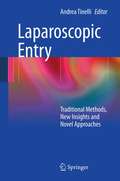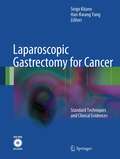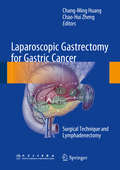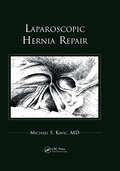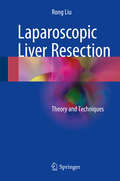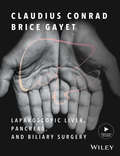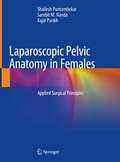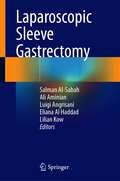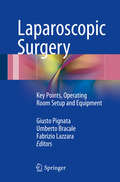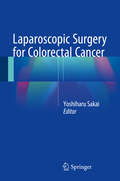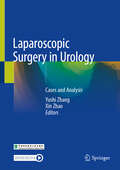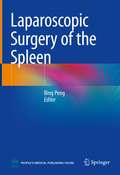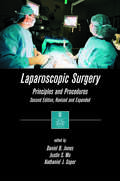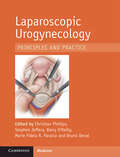- Table View
- List View
Laparoscopic Entry
by Andrea TinelliLaparoscopic Entry: Traditional Methods, New Insights And Novel Approaches discusses traditional methods of laparoscopic surgery, new devices, laparoscopic entry in difficult patients, robotic assisted surgery access, single port entry, gasless access, transvaginal entry and natural orifice surgery. This book illustrates, through the presentation of techniques, methods, photos, images, drawings and pictures, all the possible methods of laparoscopic entry for endoscopic surgeons, either for laparoscopy or for robotics. Laparoscopic Entry: Traditional Methods, New Insights And Novel Approaches describes problems and criticisms of each method and highlights common and rare complications.Written by experts in the field, this book also includes tips and tricks, which can be tailored to each patient, making it a valuable reference tool for gynecologists, urologists, vascular and general surgeons.
Laparoscopic Gastrectomy for Cancer
by Seigo Kitano Han-Kwang YangThe first laparoscopy-assisted gastrectomy for gastric cancer was performed in Japan in 1991. In the ensuing 20 years, at first through a process of trial and error, then through the sharing of master surgeons' accumulated experience, the procedure has been honed and refined to its current high level. From the beginning, it soon became evident that this much less invasive form of gastrectomy, in comparison with traditional open surgery, led to improved quality of life for postsurgical patients, and use of the procedure spread rapidly among gastric surgeons. Early on, however, there were calls for the establishment of standard techniques and procedures to be followed, with a recognized need to improve the level of safety and the quality of lymph node dissection for local control in cancer treatment. Toward that end, the Laparoscopy-Assisted Gastrectomy Club was formed in 1999. In the following year, because both Japan and Korea experience a high rate of gastric cancer, specialists from those two nations came together to form the Japan-Korea Laparoscopic Gastrectomy Joint Seminar, to facilitate and encourage the exchange of vital information. The result has been to achieve an evolving consensus among specialists in the field of endoscopic surgery in Japan and Korea with expertise that can be shared worldwide. A compilation of the current state-of-the-art is now presented in this volume, with accompanying DVD, which will be of great value to all endoscopic surgeons who perform laparoscopic gastrectomy.
Laparoscopic Gastrectomy for Gastric Cancer
by Chang-Ming Huang Chao-Hui ZhengThis book presents surgical techniques and detailed illustrations of laparoscopic gastrectomy for gastric cancer, focusing on effective, concise steps and techniques. It describes in detail the perigastric anatomy, and the incidences of each anatomical structure are analyzed statistically. It also discusses lessons learned and best practices in the management of gastric cancer patients, and includes video captures of precise operational techniques -essential resources for gastrointestinal laparoscopic surgeons. Given its close connection to clinical practice, it offers a valuable reference work for general surgeons and residents.
Laparoscopic Hepatectomy
by Xiujun CaiThis book introduces laparoscopic surgeries in liver resection using the technique of curettage and aspiration. Surgical procedures, techniques and special instruments are described in this book. Each step is explained and illustrated with high-quality figures, hand-drawings and videos. This atlas will serve as a step-by-step guide for laparoscopic liver resection.
Laparoscopic Hernia Repair
by Michael S KavicLaparoscopy is increasingly being used as an alternative to more invasive surgical techniques. This book details newly revealed anatomical dynamics of the lower abdominal wall and introduces the reader to laparoscopic repair of the inguinal hernia.
Laparoscopic Liver Resection
by Rong LiuThis book provides a comprehensive guide to the use of laparoscopic resection in the treatment of surgical liver lesions. As it introduces the steps and key techniques of laparoscopic anatomical liver resection, it will be of great interest to surgeons and physicians working in this area. Though each chapter covers a different technique, all chapters are written in a uniform style, including indications and contraindications, surgical steps, key techniques, complications and notes. This book provides readers with an overview of the current state of the art and deeper understanding of laparoscopic liver resections.
Laparoscopic Liver, Pancreas, and Biliary Surgery: Textbook And Illustrated Video Atlas
by Claudius Conrad Brice GayetLaparoscopic Liver, Pancreas and Biliary Surgery: Textbook and Illustrated Video Atlas is the perfect learning tool for all surgeons managing patients requiring advanced liver, pancreas and biliary surgery minimally invasively. This highly immersive text and video atlas will provide surgeons from trainee to advanced levels of practice, including, general surgeons, hepato-pacreatico-biliary surgeons, transplant surgeons and surgical oncologists, with a step-by-step, multi-media teaching atlas on performing laparoscopic liver surgery, anatomically correct, safely and effectively. The atlas will teach the surgeons to perform anatomic liver resections of each liver segment expertly and logically, and will cover lobectomies, extended resections, advanced laparoscopic pancreas surgery (including Whipple) and other procedures. A special emphasis is placed on reproducibility of excellence in surgical technique. Each video will be supported by outstanding illustrations for each technique and 3D renderings of the relevant anatomy. The educational step-by step high-definition videos teach everything you need to know, including critical aspects like patient positioning, port placement, dissection and much more. Led by the pioneers in laparoscopic liver, pancreas and biliary surgery, Brice Gayet and Claudius Conrad, the textbook-chapters will be authored by world experts and will contain surgical tips and tricks garnered from their unique experiences, to improve care, management of complications, relevant society guidelines and excellence in oncologic care for patients with hepato-pancreato-biliary cancers.
Laparoscopic Pelvic Anatomy in Females: Applied Surgical Principles
by Shailesh Puntambekar Sambit M. Nanda Kajal ParikhThis book offers a concise and easy-to-understand overview of facts and concepts in pelvic anatomy. Laparoscopy provides good vision in a limited field, which means that surgeons have to rely on their anatomical knowledge of what structures lie in the vicinity and which structures need to be preserved. Focusing on surgical anatomy, the book helps laparoscopic surgeons better understand the female pelvic structures so improve their surgical skills.
Laparoscopic Sleeve Gastrectomy
by Luigi Angrisani Salman Al-Sabah Ali Aminian Eliana Al Haddad Lilian KowThis book provides a complete guide to laparoscopic sleeve gastrectomy and the management of obesity. The chapters discuss guidelines for healthcare providers for the management of patients with obesity, the rationale behind choosing patients, performing the procedure in line with the patient’s condition, the perioperative period, postoperative requirements, and postoperative complications.This book aims to give readers an understanding of the surgical techniques involved in laparoscopic sleeve gastrectomy and the wider treatment options available. It is relevant to bariatric, metabolic, and general surgeons, physicians, clinical nutritionists as well as students.
Laparoscopic Surgery
by Giusto Pignata Umberto Bracale Fabrizio LazzaraThis book is distinctive in that it is a truly practical guide to use of the laparoscopic approach for the treatment of many abdominal diseases. Rather than simply offering a general description of surgical laparoscopic techniques, it provides the knowledge required in order to introduce basic laparoscopic procedures into daily practice or to commence advanced laparoscopic surgery. For each surgical procedure, key points are highlighted, the necessary equipment is described, and the operating room setup essential to avoid errors or loss of time is explained. Many flow charts, tables, and figures are included to assist fast and intuitive comprehension. The book will be of interest to all of the "actors" in the operating room, including especially surgeons in training, established surgeons, nurses, and anesthetists.
Laparoscopic Surgery for Colorectal Cancer
by Yoshiharu SakaiThis book provides simplified principles of surgical anatomy for colorectal cancers with sophisticated drawings, standard laparoscopic procedures with striking photographs and illustrations, and advanced procedures such as lateral pelvic node dissection and "down to top" or "reverse" total mesorectal excision. Oncological safety as well as minimum invasiveness of laparoscopic surgery for colorectal cancer has been acknowledged worldwide, based on long-term outcomes of several randomized controlled trials comparing laparoscopic surgery and open surgery. Developments in optical devices have provided us with a magnified clear vision of fine anatomical structures, facilitating our understanding of surgical anatomy and surgical procedures have been refined and improved accordingly. All these topics are presented in this book--valuable for surgical residents and experts eager to learn more about laparoscopic colorectal surgery--and readers will be enlightened by a new paradigm for "lap-enhanced surgical anatomy". Therefore this volume will greatly benefit not only colorectal surgeons but also general surgeons as well as gastroenterologists and oncologists.
Laparoscopic Surgery in Urology: Cases and Analysis
by Xin Zhao Yushi ZhangThis book is an atlas of laparoscopic urologic surgery based on real clinical cases, meticulously selected to represent a wide range of scenarios encountered in practice. It stands apart from conventional surgical texts by not only detailing standard procedures but also addressing complex, non-standard surgeries, thereby reflecting the true nature of clinical work. By including cases with surgical errors and their subsequent analysis, the book offers a realistic portrayal of the surgical process, aligning with the cognitive habits of medical professionals and enhancing practical knowledge. The chapters cover a broad spectrum of topics, including the positioning of laparoscopic surgery in urology, retroperitoneal adrenal and renal surgeries, and advanced bladder and prostate procedures. Readers will explore laparoscopic retroperitoneal adrenalectomy, nephrectomy, and robot-assisted techniques, gaining insights into the challenges and solutions inherent in these operations. The book also addresses critical questions such as the management of adrenal tumors, the intricacies of partial nephrectomy, and the application of robotic assistance in complex cases. Laparoscopic Surgery in Urology is designed for urologists, surgeons, and medical professionals who aim to deepen their understanding of laparoscopic techniques. It is particularly beneficial for those involved in surgical education and training, offering a practical guide to the complexities of urologic surgery. Scholars and practitioners will appreciate the book's detailed analysis and real-world approach, which provide a unique perspective on the intricacies of surgical practice. Whether you are a seasoned practitioner or a resident in training, this book will serve as an invaluable resource, enhancing your proficiency and confidence in the field of urology. The translation was done with the help of artificial intelligence. A subsequent human revision was done primarily in terms of content.
Laparoscopic Surgery of the Spleen
by Bing PengThis book presents the latest advances in laparoscopic spleen surgery. The first chapter reviews current status of laparoscopic spleen surgery, including indications, contraindications, and various types of surgical techniques. In the following three chapters, anatomy of spleen, pathology of spleen diseases, and perioperative management are described. After that, surgical techniques of laparoscopic splenectomy, single-incision laparoscopic splenectomy, hand-assisted laparoscopic splenectomy, and laparoscopic partial splenectomy are introduced with high-resolution illustrations combined with typical clinical cases. Focusing on minimally invasive surgery in spleen, this book will be a valuable reference for general surgeons, as well as practitioners in related disciplines.
Laparoscopic Surgery: Principles and Procedures, Second Edition, Revised and Expanded
by Daniel B. JonesExpanded by 30% to explore the latest surgical approaches, techniques, equipment, and perspectives, this Second Edition leads surgeons through new applications in minimally invasive surgery, gynecology, urology, endoscopically-assisted plastic surgery, pediatric surgery, and video-assisted thoracoscopic procedures.
Laparoscopic Urogynecology: Principles and Practice
by Christian Phillips Stephen Jeffery Barry O’Reilly Paraiso, Marie Fidela R. Bruno DevalLaparoscopic surgery for the treatment of disorders such as urinary incontinence and pelvic organ prolapse is evolving rapidly with few resources available for clinicians. This text will act as a gold standard reference in the field of laparoscopic urogynaecological surgery. The introductory section covers the basics of laparoscopy, including patient selection, surgical set up and the prevention and management of complications. Further sections focus on different “gold standard” techniques and the procedural steps needed to perform the surgery, including chapters on colposuspension, paravaginal repair, laparoscopic hysterectomy as well as apical suspensory surgery such as sacrocolpopexy and sacrohysteropexy. The final section includes debates and opinion pieces on newer techniques as well as discussion on the use of mesh in treating pelvic organ prolapse. There is also a section addressing the current rise in robotic surgery. The editors and contributors are all experts in the field, providing an authoritative and global view on techniques. Highly illustrated, with videos demonstrating the techniques, this is an eminently practical guide to the use of laparoscopy in urogynaecology.
Laparoscopic and Robotic Incisional Hernia Repair: Current Considerations
by Karl A. LeBlancThe field of hernia repair, in general, has evolved over the last 25 years. The changes that have followed the introduction of this technique have continued and have even increased in the last few years. There is a need to inform the practicing general surgeon about these advances. This text will seek to present the most up to date and important considerations to date. The book will open with a brief history and evolution of the technology surrounding the repair of incisional and ventral hernias laparoscopically and include the introduction of the robotic technology. Prosthetic biomaterials are an integral part of the successful repair of hernias and a comprehensive presentation of these products will be presented. Preoperative preparation of the patient has now been recognized as a method to improve outcomes in these patients and will be addressed.Technical aspects of the repair of these hernias will then follow in an orderly fashion to include the general considerations of the methodology. The “best practices” of these methods will be presented with appropriate figures and illustrations. The management of difficult situations as well as expected outcomes will be discussed. It is the intent of this text that any surgeon interested in the use of the minimally invasive techniques to repair the incisional and ventral hernias of the abdominal wall will have this resource presenting current opinions and methods. The “thought leaders” in these methods will be the authors of these chapters.This title differs from the Springer related title Novitsky, Hernia Surgery. The Novinsky is more comprehensive at 530 pages. It contains many more illustrations and video. The LeBlanc focuses on Laparoscopic and Robotic Hernia surgery with an estimated page count of 300-350. The LeBlanc presents current opinions of the thought leaders. Therefore, the subtitle: Current Considerations.
Laparoscopic and Robotic Surgery in Urology
by Xu ZhangThis book is a practical guide to the laparoscopic and robotic surgery technique in urology. It includes 34 chapters in three sections, which are adrenal gland, kidney and ureter surgery, bladder and prostate surgery and lympadenectomy. This book covers all parts of laparoscopic and robotic urological surgery, including methods in patient selection, peri-operative management, step-by-step descriptions of specific techniques and complication avoidance. It is accompanied with over 800 illustrations and real-time capture figures. It also includes over 40 surgery videos with online access. Through the combination of texts, pictures and videos, it presents the surgical designing, surgical procedures and surgical techniques in panorama. This book is a good reference book for urologists who interested in these techniques.
Laparoscopy in Children
by Salmai Turial Felix SchierWhen Laparoscopy in Children was first published in 2003, it quickly became popular with pediatric surgeons worldwide owing to its clear schematic drawings and concise text. This new edition has been revised and enlarged to cover the new procedures and other advances that have emerged in the intervening period, during which the number of operations has almost doubled. Now, the vast majority of indications for laparoscopy in children are presented and discussed. Each operation is systematically described and illustrated step by step, providing the reader with the technical guidelines required to perform laparoscopy safely even in small children. Laparoscopy in Children will be an invaluable guide for all surgeons who perform, or plan to perform, such operations.
Large Animal Clinical Procedures for Veterinary Technicians (2nd edition)
by Kristin J. Holtgrew-BohlingCovering the role of the veterinary technician in large-animal care, Large Animal Clinical Procedures for Veterinary Technicians, 2nd Edition provides a comprehensive guide to large-animal clinical diagnostic, medical, and surgical procedures. Not only does this book show why and how each procedure is performed, but it shows the vet tech's role in preparing for, assisting in, and following up on each one. Coverage of herd health care helps you understand the essentials of behavior and handling, safety, breeds, vaccination schedules, and common parasites. This edition adds case studies and clinical applications in each chapter, and a new section with an overview on livestock management. Written by educator and horse stable owner Kristin Holtgrew-Bohling, this book helps you pass your boards and gain certification, and can also be used as an on-the-job reference. A focus on the veterinary technician's role includes a description of each procedure in terms of the vet tech's responsibilities, explaining why and how the procedure is performed. Full-color photographs and line drawings show restraint, bandaging, physical examination techniques, and diagnostic procedures. A practical approach makes this text useful in classes and in clinical situations, so veterinary technicians, acting under instructions of veterinarians, can plan and follow through on procedures and treatment regimens for large animals. Proper medical terminology and common/layperson terminology are both used, helping you communicate effectively with clients and with other professionals. AVMA accreditation is promoted through coverage of the essential large animal-related tasks in the CVTEA Manual of Accreditation for Veterinary Technology Programs. New section on the livestock industry provides a wider background of herd health care so you can better understand the practices, procedures, and decisions of large animal veterinary medicine. New section on llamas and alpacas helps you understand the health and maintenance of these increasingly popular domestic animals -- in the U. S. , there are more than 12,000 alpaca herds and 25,000 llama owners. Emphasis on husbandry demonstrates how everyday housing and feeding affect care of common large animal diseases, including client education. Addition of case studies and clinical applications to each chapter helps you develop skills such as good history taking, decision making, and thinking on your feet. Coverage of herd health care includes behavior and handling, safety, breeds, vaccination schedules, and common parasites. Vet Tech Threads focus your learning with learning objectives, key terms, chapter outlines, and Technician Notes. Other added coverage includes photos of breeds and vaccination and parasite tables.
Large Animal Medicine for Veterinary Technicians
by Sue Loly Heather HopkinsonLarge Animal Medicine for Veterinary Technicians provides comprehensive guidance on caring for horses, cattle, camelids, small ruminants, pigs, and other farm animals. Reflecting the topics required by the American Veterinary Medical Association (AMVA), this practical resource covers hospital biosecurity, restraint, physical examinations, clinical and diagnostic procedures, reproduction, nutrition, disease, and more. Detailed chapters written by expert contributors contain numerous full-color images, clinical applications, self-review questions, and accurate, species-specific information. The second edition features revised and new content throughout, including brand-new chapters on common surgical procedures and general anesthesia, dentistry, and popular hobby farm animals such as fowl, poultry, and pet pigs. Updated and expanded sections on neonatology, diagnostics, and imaging are supported by a wealth of new images and examples. Covering the skills and knowledge necessary for success in both Veterinary Technician Specialty (VTS) programs and in clinical practice, this must-have guide: Offers new coverage of imaging and diagnostic technologies such as dynamic endoscoping and the use of treadmills Contains more than 500 high-quality color images, multiple-choice questions with answers, and a glossary of terms Features a range of pedagogical tools including learning objectives, clinical case problems, charts and diagrams, and “Technician Tip” boxes Includes a significantly expanded companion website with self-review questions, case studies, PowerPoint slides, and an image bank to aid in breed identification Authored and edited by experienced trainers and certified veterinary technicians, Large Animal Medicine for Veterinary Technicians, Second Edition an invaluable reference for all students, educators, and working professionals in the field.
Large Animal Medicine for Veterinary Technicians
by Sheryl Ferguson Laura Lien Sue LolyThis comprehensive guide to all aspects of caring for horses, cattle, camelids, small ruminants, and pigs helps veterinary technician students learn everything they need to know about large animal medicine. Presented in full-color, Large Animal Medicine for Veterinary Technicians provides species-specific coverage with a wealth of images, as well as clinical applications. Coverage includes AVMA-required topics such as hospital biosecurity, restraint, physical examinations, nutrition, clinical and diagnostic procedures, reproduction, neonatology, and disease. To reinforce the text, an accompanying website offers review questions and answers, case studies, and an image bank with additional photographs to aid in breed identification. Veterinary technician students, veterinary technician educators, and veterinary technicians in practice who wish to foster and expand their knowledge of large animal medicine will find Large Animal Medicine for Veterinary Technicians an invaluable resource.
Large Animal Neurology
by Joe Mayhew Rob MacKayA comprehensive and authoritative guide to neurologic disease in large domestic animals, world-wide. The newly revised Third Edition of Large Animal Neurology delivers a practical and complete reference for veterinarians, veterinary trainees and scientists dealing with large animal neurology. The book is vividly illustrated in full colour and contains many clinical photographs and detailed line drawings to highlight the concepts discussed within. Organised into three parts, Large Animal Neurology offers practitioners and students straightforward guides on how to perform neurologic examinations for domestic large animal species, including neonates. It also discusses the presenting clinical syndromes caused by common nervous system diseases, as well as giving details of the specific neurologic diseases of large domestic animals. The book includes: A thorough introduction to the evaluation of large animal neurologic patients, including discussions of neuroanatomy, neurologic evaluation, ancillary diagnostic aids, and the important pathologic responses of the nervous system Comprehensive exploration of 26 presenting clinical problems, including behaviour disorders, seizures, epilepsy, sleep disorders, blindness, strabismus, monoplegia, wobblers, tetraplegia, pruritus and cauda equina syndrome Detailed coverage of the specific diseases, including those of genetic, infectious, nutritional, toxic and metabolic cause, and the many diseases with multifactorial and with unknown cause Perfect for all equine and farm animal veterinarians, veterinary neurologists, as well as trainees in the field, Large Animal Neurology, Third Edition is also an ideal resource for undergraduate veterinary students, animal pathologists, and neuroscience researchers.
Large Animal Parasitology Procedures for Veterinary Technicians
by Donald H. BlissLarge Animal Parasitology Procedures for Veterinary Technicians Comprehensive illustrated reference on parasitic nematodes, cestodes, coccidian oocysts and trematode egg recoveries, identification, and enumeration with treatment strategies for five separate categories of animal patients Large Animal Parasitology Procedures for Veterinary Technicians illustrates, in detail, the most sensitive diagnostic procedure for internal parasites of domestic animals using the Modified Wisconsin Sugar Flotation Method. With step-by-step pictures and bullet-point instructions, this text discusses sample collection and storage techniques, as well as the strengths and weaknesses inherent to other commonly used tests. Potential sources for infection, the seasonality of the infection, possible environmental recontamination, and control strategies are all covered in detail, with suggestions to prevent reoccurrences. Parasites of the equine, large and small ruminants (including alpaca), swine, poultry and hoofed wildlife patients are included, with full color images for quick identification, an assessment of life cycle stage, and discussion of zoonotic potential. Each species section is heavily illustrated with comparative images to aid the technician in quickly identifying the parasite and life cycle stage. In Large Animal Parasitology Procedures for Veterinary Technicians, readers can find information on: The definition and economic importance of parasitisms, details on the epidemiology of parasitic enteritis, including basics of protozoology, helminthology, and overall applied veterinary parasitology Sample collection and shipment of specimens, including collection, storage, examinations, and interpretations Fecal examination using the Modified Wisconsin Sugar Flotation method, compared with gross examination, smear, sedimentation, and other flotation techniques, plus a fluke egg recovery technique and the Baermann technique for lungworm larvae recovery Internal parasite diagnosis and worm egg recoveries, descriptions and pictures of nematode parasite eggs (as well as coccidia oocysts), plus tapeworm eggs and fluke egg descriptions and photos for a variety of host animals Illustrating commonly used diagnostic tests in veterinary parasitology, with step-by-step instructions for accuracy, Large Animal Parasitology Procedures for Veterinary Technicians is an essential reference for veterinary technicians and veterinary technician students dealing with domestic animals, including horses, ruminants, swine, poultry, and hoofed wildlife.
Large Camel Farming: A Care-Management Guide from Breeding to Camel Products
by Bernard Faye Gaukhar Konuspayeva Cécile MagnanThis practical guide is intended for all actors in the sector who work with large camelids, whether in breeding, technical advice or veterinary care. It successively describes the general aspects of the species, the physiological bases of reproduction, lactation and feeding, the main production processes, and health and hygiene management in camel breeding. Chapters on slaughter, important camel products and their processing complete the volume.Large camels (camels and Bactrian camels) are domestic animals that are increasingly used in Western countries, as well as in Africa and Asia, for tourism, sport, and production of milk, meat, and wool. In addition, camel husbandry systems are changing, taking a greater share of sedentary systems, specializing in breeding, and intensifying production. At the same time, many veterinarians and breeders are not familiar with the animal, its needs, physiology, diseases, and management, which is often based on practices introduced for cattle and proving ineffective.This work is a practical aid for all interested readers who want to embark on the adventure of working with large camelids in a cultural context where they are not yet a dominant element of the agricultural landscape. The numerous photographs and drawings that support the text make it a unique and entertaining read.
Large Language Models (Methods in Molecular Biology #2941)
by Dukka B. KcThis book presents a comprehensive collection of methods, resources, and studies that use large language models (LLMs) in the field of protein bioinformatics. Reflecting the swift pace of LLM development today, the volume delves into numerous LLM-based tools to investigate proteins science, from protein language models to the prediction of protein-ligand binding sites. Written for the highly successful Methods in Molecular Biology series, chapters include the kind of detailed implementation advice to ensure success in future research. Authoritative and practical, Large Language Models (LLMs) in Protein Bioinformatics serves as an ideal guide for scientists seeking to tap into the potential of artificial intelligence in this vital area of biological study.
